Things to Do in Guangzhou: The Complete Expert Guide
Guangzhou pulls you into its embrace like a warm bowl of congee on a rainy morning. We’ve spent years exploring this vibrant metropolis where ancient temples sit alongside neon-lit skyscrapers, where elderly locals practice tai chi at dawn while young professionals rush to gleaming office towers.
Most visitors rush through Guangzhou between flights or Canton Fair appointments. They miss the real magic—steaming har gow emerging from bamboo steamers at 7 AM teahouses, elderly neighbors playing mahjong in centuries-old courtyards, master craftsmen hand-pulling rice noodles unchanged for generations, and hidden speakeasies behind unmarked doors that transport you to 1920s Shanghai.
This guide shares what we’ve learned from countless trips and deep local connections. You’ll discover experiences that transform Guangzhou from a quick stopover into an unforgettable destination that lingers in memory long after you’ve left. Every best things to do in Guangzhou.
Table of Contents
Why Guangzhou Deserves More Than 24 Hours
The Canton Fair attracts over 246,000 overseas buyers from 215 countries twice yearly in October-November and April-May. But treating Guangzhou as merely a business hub means missing China’s third-largest city at its most authentic—a city where 2,000 years of trading port history pulses through modern streets.
We’ve watched this city evolve dramatically. As of November 2025, the Guangzhou Metro operates 19 lines spanning over 620 kilometers with 271 stations, making exploration incredibly accessible. The system rivals Tokyo’s efficiency while costing a fraction of the price—most journeys under ¥10.
The food scene alone justifies extended stays. Guangzhou birthed Cantonese cuisine—the refined cooking style that conquered the world’s Chinatowns through generations of emigration. But what you taste here bears little resemblance to overseas interpretations. The dim sum achieves levels of refinement impossible to replicate elsewhere because raw ingredients arrive daily from nearby farms and fishing ports, and chefs trained under masters who learned from their masters going back centuries.
Part 1: Essential Preparations
1.1 Mastering the Metro System
Wongchito, CC BY-SA 4.0 <https://creativecommons.org/licenses/by-sa/4.0>, via Wikimedia Commons
Public transportation transforms your Guangzhou experience from stressful to seamless. Most metro lines operate daily from 6:00 AM to 11:30 PM, with fares starting at just ¥2. This extensive network puts virtually every major attraction within 30 minutes of each other.
Download the official Guangzhou Metro app before arriving—English navigation works surprisingly well, though occasional translation quirks provide entertainment. We strongly recommend purchasing a Yang Cheng Tong card at any station ticket office. This rechargeable card offers 5-10% discounts on metro fares and works on buses too. The card requires ¥20 deposit (refundable when you leave) plus whatever credit you add. We typically load ¥100 initially, which lasts several days of heavy sightseeing.
Critical Transfer Hubs:
Gongyuanqian Station (Lines 1 & 2) serves as the heart of old Guangzhou. Exit here for Beijing Road shopping street, Temple of the Six Banyan Trees, and traditional neighborhoods. The station itself showcases fascinating historical exhibits about Guangzhou’s ancient city walls—worth arriving early to explore.
Zhujiang New Town Station (Lines 3, 5 & APM) anchors the modern business district. Multiple exits connect to different parts of this sprawling area. Exit B1 leads directly to underground shopping malls. This station can feel overwhelming initially—crowds surge in confusing directions—but follow clear English signage.
Canton Tower Station (Line 3 & APM) delivers you directly to Guangzhou’s iconic landmark. The APM line connection provides quick access to Zhujiang New Town hotels and restaurants.
Line 22 Express connects Guangzhou South Railway Station to Baiyun Airport terminals in just 25 minutes. This route saves enormous time compared to taxis during rush hour when traffic transforms the same journey into a 90-minute ordeal costing ¥150+.
Avoid traveling between 7:30-9:30 AM and 5:30-7:30 PM when trains become unbearable sardine cans. Plan morning dim sum before 8 AM and afternoon attractions after 10 AM strategically.
READ ALSO: Where to Stay in Guangzhou: Complete Guide to Best Areas & Hotels
1.2 Money & Communication
Cash remains surprisingly important despite China’s digital payment dominance. ATMs are ubiquitous. Bank of China ATMs reliably accept foreign cards with reasonable exchange rates. Maximum withdrawal limits typically range ¥2,500-3,000 per transaction.
Budget travelers manage on $40-60 daily including hostel accommodation ($10-15), street food and local restaurants ($15-20), and public transportation exclusively ($5-8). Mid-range visitors spending $80-120 enjoy comfortable hotels ($40-60), quality restaurants including occasional upscale dim sum ($30-40), and convenient transportation including occasional taxis ($10-15). Luxury standards costing $200+ daily provide five-star hotels, Michelin-starred restaurants, private guides, and premium experiences.
Download translation apps like Pleco (specifically for Chinese) or Google Translate before arriving. The photo translation feature proves invaluable for reading menus, signs, and instructions. Download offline language packs to avoid data dependency.
Learn basic Mandarin phrases: “Xie xie” (thank you), “duo shao qian” (how much), “zhe ge” (this one, while pointing), “tai gui le” (too expensive—useful when shopping), and “wo shi su shi zhe” (I’m vegetarian, if applicable).
1.3 Weather & Best Visiting Times
Season | Temperature | Conditions | Crowd Levels | Best For |
|---|---|---|---|---|
Spring (Mar-May) | 18-28°C | Warm, humid, occasional rain | Moderate | Comfortable sightseeing, spring flowers, pleasant evenings |
Summer (Jun-Aug) | 28-35°C | Hot, humid, frequent storms | Lower | Fewer tourists, best hotel rates, indoor attractions |
Autumn (Sep-Nov) | 20-28°C | Pleasant, dry, clear skies | High | Perfect weather, Canton Fair periods, outdoor activities |
Winter (Dec-Feb) | 10-20°C | Cool, dry, sunny | Low | Spring Festival atmosphere, less humidity, good deals |
Spring and autumn provide pleasant weather ideal for outdoor activities. Summer visitors should embrace the heat—start days early (6-8 AM), retreat indoors during peak afternoon heat (1-4 PM), then emerge for evening exploration. Afternoon thunderstorms usually arrive around 3-5 PM, lasting 30-60 minutes before clearing into beautiful evenings.
Avoid the first week of October (National Holiday) when domestic tourism peaks catastrophically. Hotels triple prices, attractions become uncomfortably crowded, and restaurants require long waits.
Part 2: Food & Culinary Experiences
2.1 Understanding Dim Sum Culture

Forget everything you know about dim sum from overseas Chinese restaurants. Yum cha literally translates as “drinking tea” and describes an entire social ritual, not merely food consumption. This tradition defines Cantonese culture more profoundly than any temple or landmark.
Traditional yum cha begins early—serious practitioners arrive by 7 AM when restaurants open. The morning ritual involves ordering tea first (always pour for others before yourself—basic etiquette), then selecting dishes as staff push carts past your table or from photo menus. Conversations flow naturally between dishes. Nobody rushes. The meal extends for hours as friends and family gather, gossip, and graze.
The dishes themselves represent culinary art forms perfected over generations. Each restaurant guards recipes and techniques passed down through master-apprentice relationships. The best establishments employ dim sum chefs with 20+ years experience who wake before dawn to prepare doughs, fillings, and specialized items.
The Four Heavenly Kings:
- Har Gow (虾饺): Shrimp dumplings with translucent rice flour skins revealing plump pink shrimp inside. Traditional har gow must have exactly 12 pleats—fewer suggests rushed preparation. The skin should be tender yet strong enough to hold together when lifted with chopsticks. Bite carefully to avoid squirting yourself with hot broth.
- Siu Mai (烧卖): Open-topped pork and shrimp dumplings crowned with crab roe or fish roe. The filling combines pork fat and lean meat in specific ratios, bound with dried mushroom and sometimes water chestnuts for texture. Quality siu mai has visible shrimp pieces and aromatic pork scent.
- Char Siu Bao (叉烧包): Barbecued pork buns achieving perfect balance between fluffy exterior and sweet-savory interior. The dough must be soft, white, and slightly sweet. The char siu filling requires hours of marination and roasting. Split the bun open to release fragrant steam before eating.
- Dan Tat (蛋挞): Portuguese-influenced egg tarts with flaky layered pastry and silky custard filling. The pastry shatters delicately when bitten. The custard wobbles slightly but holds its shape. Eat these fresh while still warm—they lose magic as they cool.
Rice noodle rolls (cheong fun) deserve special attention as Guangzhou’s signature contribution to dim sum. Thin rice flour sheets are steamed, rolled around various fillings (shrimp, beef, char siu, vegetables), then topped with sweet soy sauce. The texture should be silky and tender, not gummy or thick.
2.2 Top Dim Sum Restaurants
Tao Tao Ju (陶陶居)
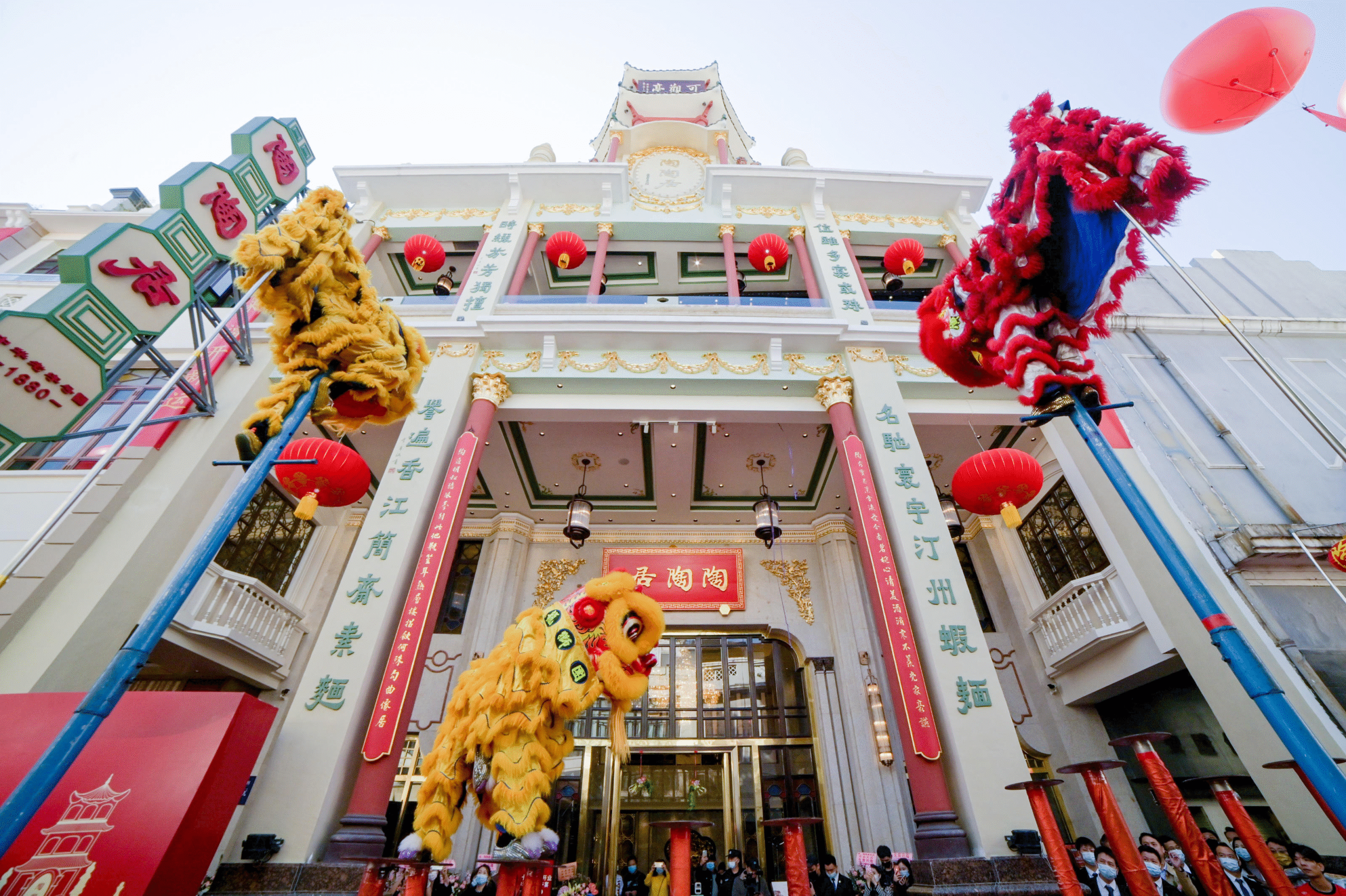
This historic establishment opened in 1880 and weathered wars, revolutions, and China’s dramatic transformations while maintaining exceptional quality. The Beijing Road location occupies a beautiful historic building with ornate woodwork and vintage tile floors that transport you to another era.
We always order har gow first as our quality test—their translucent skins achieve near-perfection with exactly 12 pleats and crystal-clear appearance revealing tender whole shrimp inside. The siu mai comes topped generously with fish roe and contains visible chunks of fresh shrimp. Their char siu bao features genuinely flaky layers and properly sweet-savory filling—not the overly sweet versions common elsewhere.
The restaurant atmosphere buzzes with energy as local families gather for their weekly ritual. Teacups clink, conversations flow in rapid Cantonese, and carts roll past laden with steaming bamboo baskets. Staff knows their regular customers and greets them warmly—a reminder that yum cha represents community tradition, not mere dining.
- Best arrival time: Before 10 AM weekdays, before 9 AM weekends
- Average cost: ¥70-150 per person depending on appetite
- Insider tip: Request a table upstairs for better atmosphere and fewer crowds
Dian Dou De (点都德)
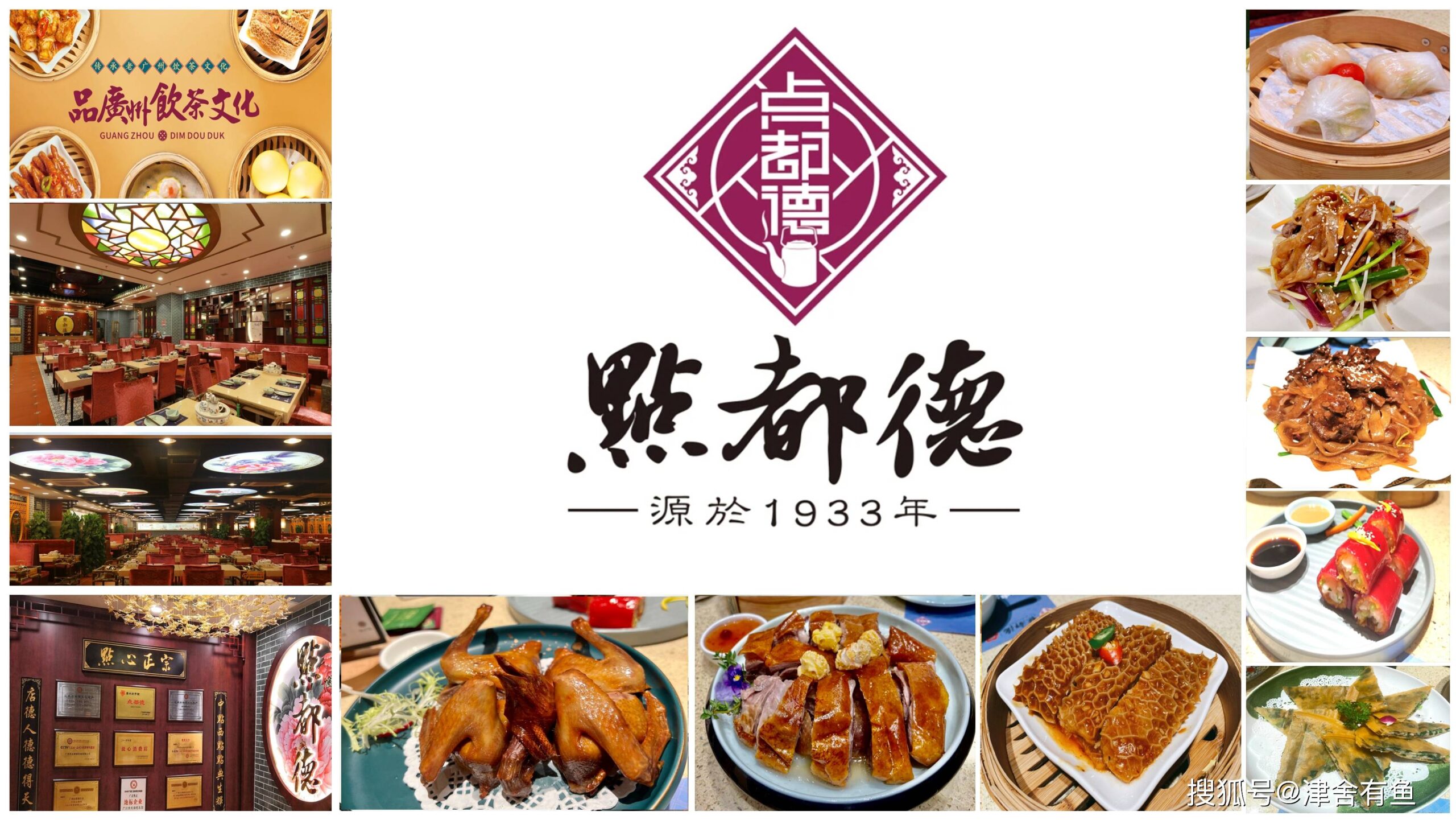
This modern chain revolutionized Guangzhou dim sum by combining traditional quality with contemporary efficiency and innovation. Eight locations dot Tianhe district alone, making this convenient for business travelers and Canton Fair attendees.
Their signature red rice rolls demonstrate creative evolution while respecting tradition. Crispy youtiao (Chinese fried dough) is wrapped with fresh shrimp inside silky rice noodle sheets, then topped with sesame sauce and seasonal soy dip featuring cilantro and lime. This dish exemplifies modern Guangzhou dining philosophy—respectful of heritage yet unafraid to experiment intelligently.
- Multiple locations: Tianhe district most convenient
- Price range: ¥100-200 per person for comprehensive meal
- Order system: Modern tablet ordering with photos (English available)
- Specialty: Innovative interpretations alongside traditional items
Hongtu Hall at White Swan Hotel

For special occasions or when entertaining important guests, this Michelin-starred restaurant specializes solely in dim sum while overlooking the Pearl River. The refined atmosphere features white tablecloths, attentive service, and spectacular river views that justify significantly higher prices.
The chef trained under Hong Kong masters before returning to Guangzhou. His har gow contains whole prawns rather than chopped shrimp, wrapped in impossibly thin skins that somehow stay intact. The char siu bao uses premium pork with complex marinade that balances sweet, savory, and umami notes perfectly.
- Location: White Swan Hotel, Shamian Island
- Reservation: Highly recommended, especially weekends
- Price range: ¥200-500+ per person
- Best for: Special celebrations, business entertainment
2.3 Beyond Dim Sum

Wonton Noodle Soup – This apparently simple dish demands incredible skill. The best shops make fresh noodles daily using specific alkaline-water ratios creating characteristic springy texture. The wontons contain whole shrimp wrapped in impossibly thin skins. The broth simmers for hours from pork bones and dried seafood. Look for small restaurants with lines of locals—always a positive sign.
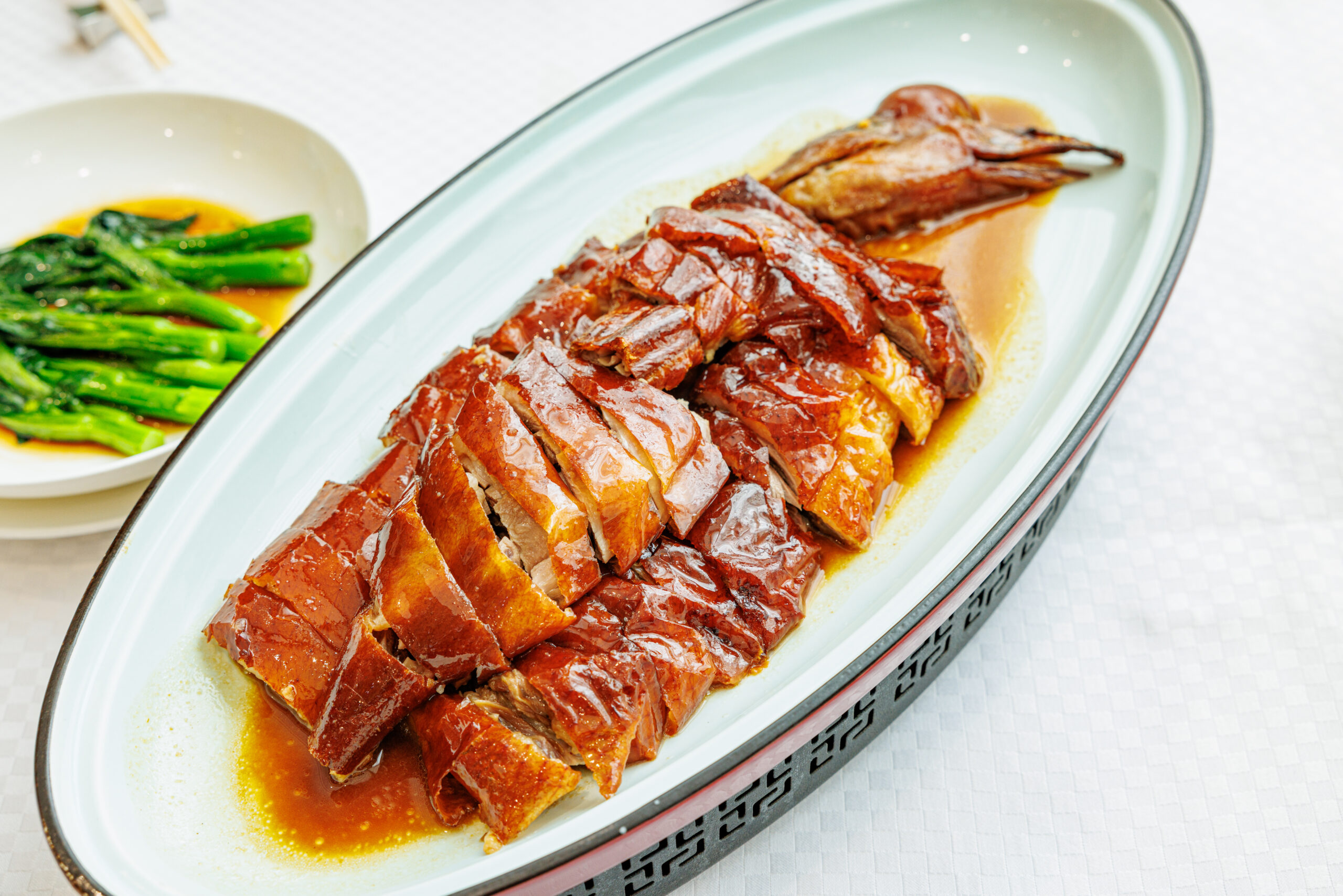
Roast Goose – Cantonese roast goose achieves crispy skin and tender meat through meticulous preparation involving air-drying, honey glazing, and precise roasting temperatures. Proper roast goose skin shatters like glass when bitten, releasing incredible aromas. Quality shops display hanging geese in windows—a sign of confidence.
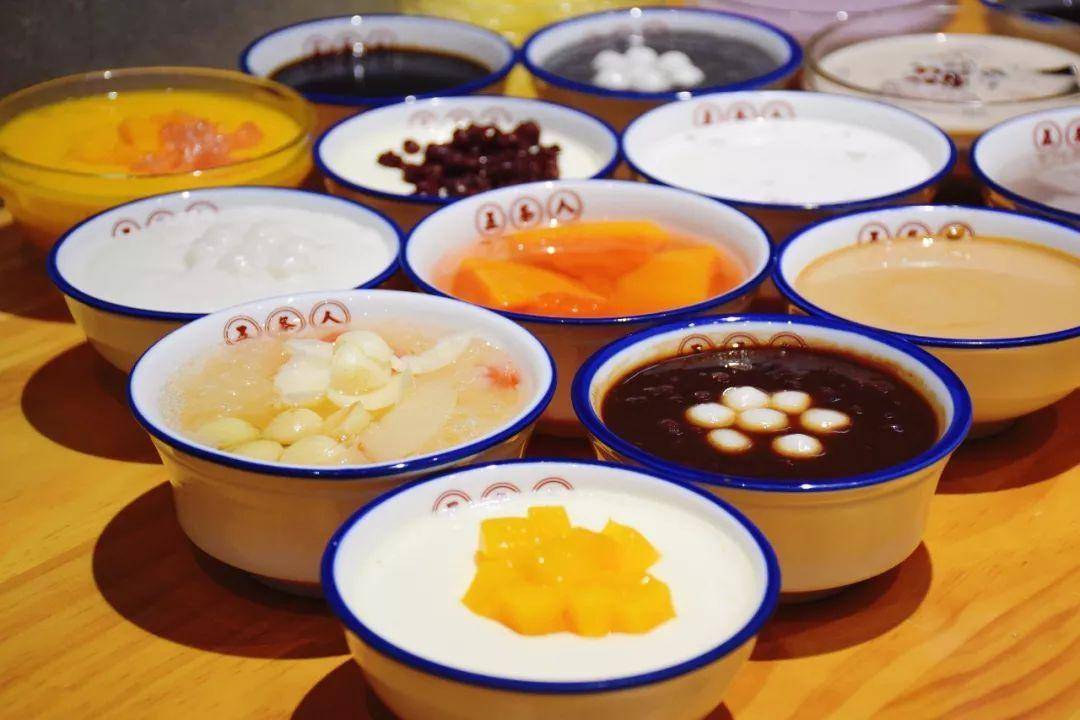
Cantonese Desserts (Tong Sui) – Traditional dessert soups range from sweet to medicinal. Red bean soup, mango pomelo sago, and double-skin milk pudding represent popular options. These aren’t Western-style sweet; they offer subtle flavors and interesting textures. Seek out small dessert shops open late into evening.
Part 3: Historical & Cultural Attractions
3.1 Chen Clan Ancestral Hall

Built between 1890 and 1894 during the late Qing Dynasty, this expansive complex covers 13,200 square meters containing 19 buildings, nine halls, and six courtyards arranged with perfect symmetry. Walking through these gates feels like stepping into a living museum where every surface tells stories through intricate artistry.
The Chen Clan Ancestral Hall was commissioned and funded by 72 Chen clan branches throughout Guangdong province to serve their juniors’ accommodation and preparation for imperial civil service examinations. This wasn’t merely an ancestral temple—it functioned as an elite academy where promising Chen family members studied classics, calligraphy, and philosophy.
The complex showcases seven traditional decoration techniques at their highest expression: wood carving, stone carving, brick carving, pottery sculpture, stucco relief, iron and copper casting, and colored painting. Master craftsmen from across Guangdong gathered here to create a showcase of regional artistic achievement.
The Pottery Ridge Crests crown the rooflines with elaborate ceramic sculptures. The main Gathering Hall ridge crest spans an incredible 27 meters, stands 2.9 meters high, and contains 224 individually crafted figures depicting classical scenes. These sculptures survived the Cultural Revolution through clever protection by local officials who recognized their irreplaceable value.
The Wood Carvings include sixteen double-sided screen doors in the Gathering Hall, each describing classic drama scenes from Romance of the Three Kingdoms and The Biography of Yue Fei. The carving depth and detail allow you to distinguish individual armor pieces, facial expressions showing emotion, and flowing fabric that seems to move.
Visit on weekday mornings between 9-11 AM for peaceful exploration. Photography is allowed everywhere except special exhibitions. Consider hiring a local guide (¥100-150 at entrance) for deeper understanding—even basic explanation enriches your appreciation dramatically.
Essential Details:
- Metro: Line 1 to Chen Clan Ancestral Hall Station (Exit D)
- Hours: 8:30 AM – 5:30 PM daily (last entry 5:00 PM)
- Admission: ¥10 (exceptional value)
- Time needed: 2-3 hours for thorough visit
3.2 Temple of the Six Banyan Trees

Originally built in 537 AD during the Southern and Northern Dynasties period, this temple represents one of Guangzhou’s four great Buddhist temples. The current name honors Song Dynasty poet Su Dongpo, who visited in 1100 AD and was so moved by six towering banyan trees that he composed a poem titled “Six Banyans.” The abbot appreciated the poem so much he renamed the entire temple.
The Flower Pagoda (Hua Ta) soars 57.6 meters making it the tallest ancient structure in Guangzhou. Despite appearing to have only nine exterior levels, the pagoda actually contains seventeen interior floors—clever architectural design that maximizes strength while maintaining elegant proportions. The pagoda earned its “Flower” nickname from colorful glazed tiles covering its eaves and intricate wooden carvings beneath each roof level.
Construction dates to 1097 AD during the Northern Song Dynasty, built on an octagonal base. The octagonal design proved more stable and allowed better weight distribution—engineering knowledge impressive for the 11th century.
The Mahavira Hall west of the pagoda contains three enormous bronze Buddha statues cast in 1663 during the Qing Dynasty. Each statue measures 6 meters tall and weighs 10 tons, making them the largest ancient bronze Buddhist statues in Guangdong Province.
Visit during early morning (7-9 AM) when local Buddhists come to pray, light incense, and make offerings. The atmosphere fills with fragrant smoke, quiet chanting, and genuine spiritual devotion.
- Metro: Line 1 to Gongyuanqian Station (Exit B1), then 10-minute walk
- Hours: 8:30 AM – 5:00 PM daily
- Admission: Temple ¥5, Pagoda ¥10 (when accessible)
3.3 Yuexiu Park & Five Rams Statue
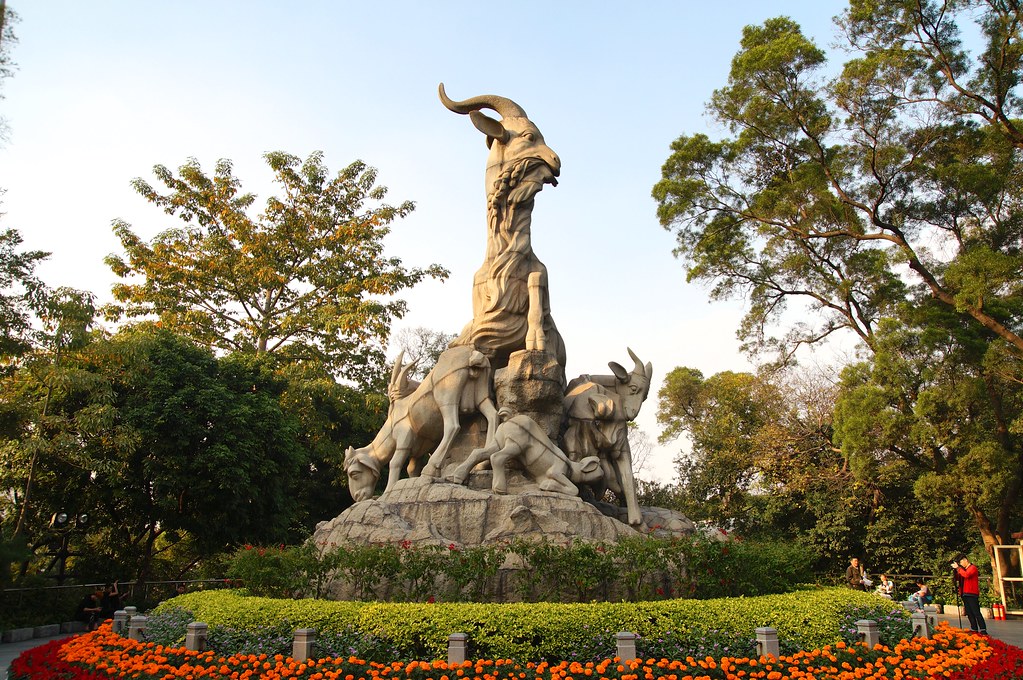
This expansive green space covers 860,000 square meters across seven hills and three artificial lakes, making Yuexiu Park Guangzhou’s oldest and largest comprehensive urban park. Established formally in 1927, the park has served as the city’s green lung and beloved recreation ground for generations.
The Five Rams Sculpture, built in 1960 from more than 130 pieces of granite, represents the legendary five celestial beings who, according to local folklore, rode into the city on rams carrying sheaves of rice, teaching residents how to grow rice and ending famine forever. This origin story gives Guangzhou its nickname “City of Rams.”
The statue stands 11 meters tall with the largest ram—a billy goat—positioned prominently in the center holding rice stalks in its mouth. The legend varies in telling but maintains consistent themes—celestial beings bringing agricultural knowledge and prosperity to struggling people. Locals consider the rams symbols of good fortune and civic pride.
Zhenhai Tower (Five-Story Tower) was built in 1380. Legend claims the builder saw yellow and purple air rising over Yuexiu Mountain—an omen suggesting a future emperor would arise here. To suppress this prophecy and protect the current dynasty, he ordered the tower built as part of the city’s defensive walls. Since 1928, Zhenhai Tower has housed the Guangzhou Museum, displaying relics chronicling the city’s 2,000+ year history.
The Ancient Ming Dynasty City Wall – A 200-meter section survives within the park, hidden among lush vegetation. This represents the only remaining ancient city wall in Guangzhou proper. Walking alongside these massive stone blocks connects you physically to Guangzhou’s defensive past.
Visit early morning (6-8 AM) to watch locals practicing tai chi, dancing, singing opera, and socializing—genuine slices of daily Guangzhou life.
- Metro: Line 2 to Yuexiu Park Station (Exit B1 for main entrance)
- Hours: 6:00 AM – 9:00 PM daily
- Admission: Free (museum entry ¥10)
- Time needed: 2-4 hours depending on interests
3.4 Museum of the Mausoleum of the Nanyue King
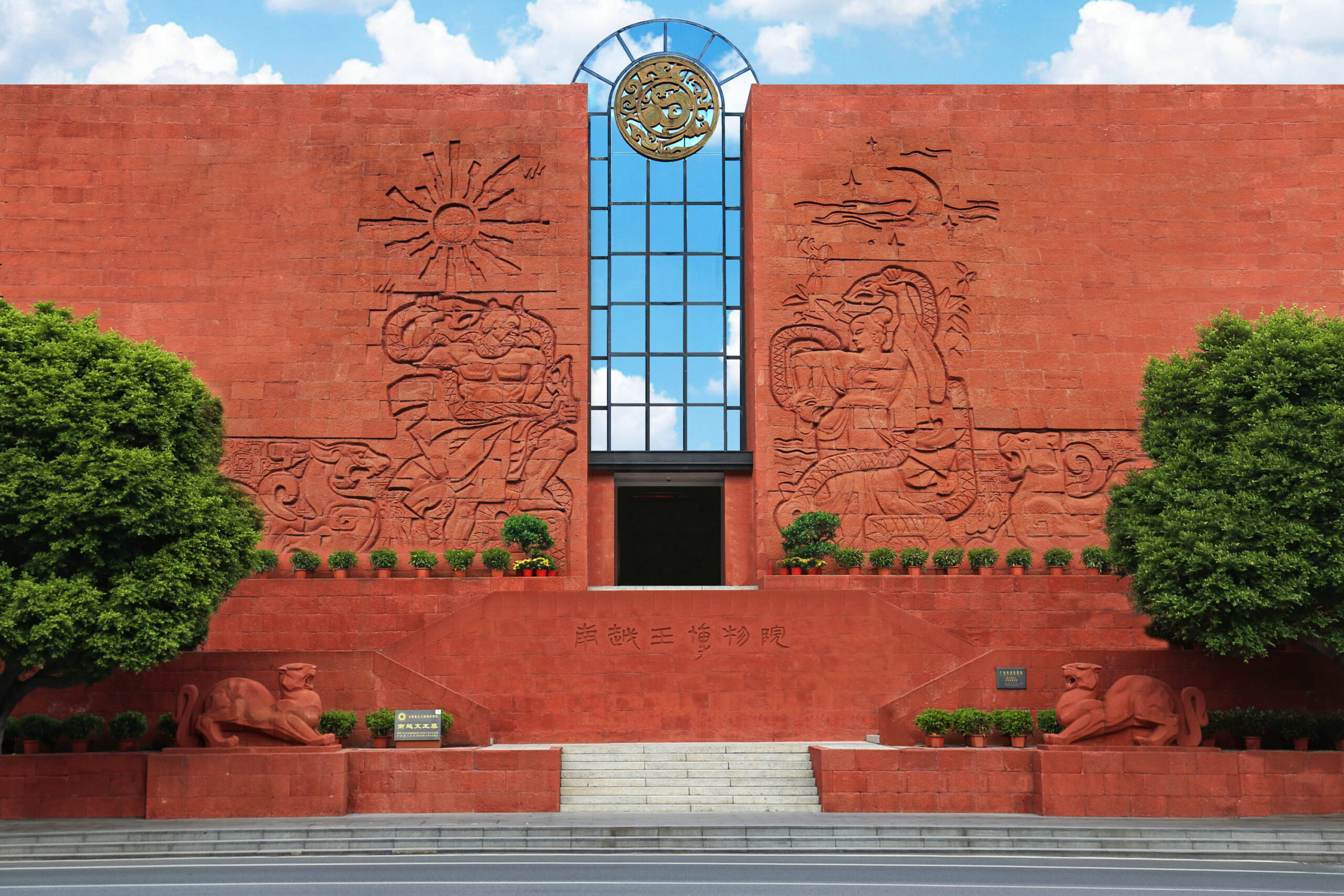
This underground archaeological museum preserves one of China’s most important Western Han Dynasty discoveries—the 2,000-year-old tomb of Zhao Mo, the second king of the Nanyue Kingdom. Discovered accidentally in 1983 during construction work, the tomb remained sealed and undisturbed for over two millennia.
The tomb contains over 1,000 precious artifacts including the famous jade burial suit—one of only five complete suits discovered in China. The suit consists of 2,291 jade pieces sewn together with red silk thread. The tomb’s design reveals sophisticated understanding of hydraulics—ancient engineers created elaborate drainage systems using sand filtration that kept the tomb dry for 2,000 years.
The collection includes stunning gold and silver artifacts—ornate seals, decorative vessels, jewelry, and ceremonial items demonstrating metalworking techniques of exceptional refinement. The museum maintains comfortable climate control and adequate English explanations. Plan 90 minutes to two hours for thorough exploration.
- Metro: Line 2 to Yuexiu Park Station (Exit E), 5-minute walk
- Hours: 9:00 AM – 5:30 PM daily (closed Mondays)
- Admission: ¥12 (extraordinary value)
- Audio guide: Available in English (¥30, recommended)
3.5 Yongqingfang: Revitalization Done Right

Located in the historic Enning Road District, Yongqingfang represents urban renewal at its most thoughtful. This national 4A scenic spot preserves old streets and alleys built hundreds of years ago while introducing contemporary uses that keep neighborhoods alive.
Enning Road boasts Guangzhou’s longest and most intact qilou (arcade house) street. These distinctive structures feature covered walkways at ground level supported by columns, with residential or commercial spaces above. The design originated in Guangzhou during the late Qing Dynasty, blending Southern Chinese traditions with influences from Southeast Asian shophouses.
The qilou style solved practical problems—covered walkways protected pedestrians from sun and rain while maintaining air circulation. Walking along these covered arcades, especially during rain, helps you understand why this architectural form dominated Southern China.
Watch traditional craftsmen practice techniques passed through generations—hand-pulling rice noodles, crafting intricate paper cuts, carving seals from stone. Many craftsmen welcome curious visitors and answer questions. Some offer brief workshops where you can try techniques under guidance.
Traditional Cantonese opera performances occur regularly. Check schedules at the visitor center. Small galleries showcase contemporary Lingnan art alongside heritage displays. Traditional snack shops sell local specialties like double-skin milk pudding, ginger milk curd, and herbal tea.
- Metro: Line 1 to Changshou Road Station (Exit D), 10-minute walk
- Hours: Open area; shops typically 10 AM-9 PM
- Best time: Late afternoon into evening when craftsmen work
- Photography: Excellent opportunities
3.6 Shamian Island: Colonial Heritage

This charming 0.3-square-kilometer island gives rare glimpses into Guangzhou’s 19th-century colonial history as a foreign trade concession. The Shamian island served as the location for British and French consulates along with foreign trading houses during Guangzhou’s pivotal role in East-West commerce.
Development began in 1861 when the Qing government leased land to Britain and France following the Second Opium War. About 150 European-style buildings survive, many protected as historical architecture. Wide pedestrian boulevards lined with ancient banyan trees create cooling shade even during summer.
We love Shamian for morning walks. The leafy boulevards remain cool and the island awakens slowly. Elderly locals practice tai chi. Young couples take wedding photos. Artists set up easels capturing architectural details.
Our Lady of Lourdes Chapel sits at the island’s western end. The Gothic revival architecture contrasts beautifully with surrounding banyan trees whose aerial roots create dramatic natural curtains.
Small cafes occupy ground floors of renovated colonial buildings, serving surprisingly good coffee—a rarity in traditional Guangzhou. Prices run higher than local restaurants but remain reasonable by international standards.
- Metro: Line 1 to Huangsha Station (Exit F), then 10-minute walk
- Hours: Open area accessible 24/7
- Best for: Photography, peaceful walks, coffee breaks
- Combine with: Qingping Market (5 minutes walk)
3.7 Qingping Market: Traditional Medicine & Local Life
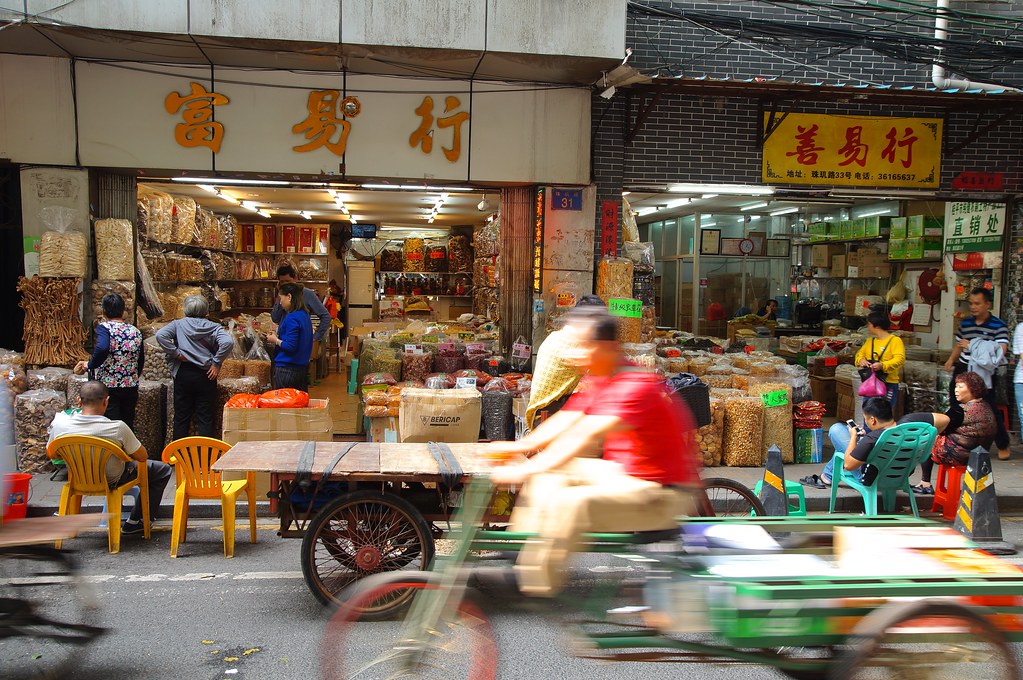
This fascinating traditional market offers glimpses into Chinese medicine practices and local daily life. Located near Shamian Island, Qingping Market has operated for decades as Guangzhou’s primary wholesale market for traditional Chinese medicine, dried seafood, and unique goods.
Qingping is one of 17 Chinese herbal medicine markets approved by the state in 1996. It’s the largest trade port and distribution center of traditional medicine in southern China, with products sold to Hong Kong, Macau, Taiwan, Southeast Asia, and beyond. The market covers 11,200 square meters with over 1,200 booths.
We won’t sugarcoat the experience—some sections sell controversial items that may disturb Western sensibilities. You’ll encounter dried seahorses, deer antlers, animal parts used in traditional medicine, and living animals. These realities require mental preparation.
However, the traditional medicine sections provide genuine cultural education unavailable in sanitized tourist attractions. Local herbalists still practice diagnosis and prescription methods unchanged for generations. Watch elderly practitioners examine tongues, check pulses, and prescribe complex herbal formulations based on traditional Chinese medicine theory.
The medicine shops display hundreds of wooden drawers and glass jars containing dried herbs, roots, bark, flowers, and minerals. Knowledgeable staff (some speaking basic English) explain uses and properties if you show genuine interest. Ginseng, cordyceps, dried goji berries, chrysanthemum flowers, and premium tea occupy prominent positions—legitimate gifts at substantially lower prices than tourist shops.
The dried seafood section features abalone, scallops, sea cucumbers, fish maw, and various shellfish. These ingredients form foundations of Cantonese premium cooking, often featured in banquet dishes and soups believed to have health benefits. The quality ranges dramatically—top-grade dried abalone can cost thousands of RMB per piece.
Visit during morning hours (8:00-11:00 AM) when market activity peaks. Vendors restock fresh inventory and serious buyers conduct business. Hiring a local guide dramatically enriches the experience—they explain what you’re seeing, teach safe herb usage, and help identify quality products.
- Metro: Line 1 to Huangsha Station (Exit F), 5-minute walk
- Hours: 8:00 AM – 6:00 PM (best before noon)
- Guide: Recommended for deeper understanding
- Caution: Traditional medicine animal products visible
Part 4: Modern Landmarks
4.1 Canton Tower
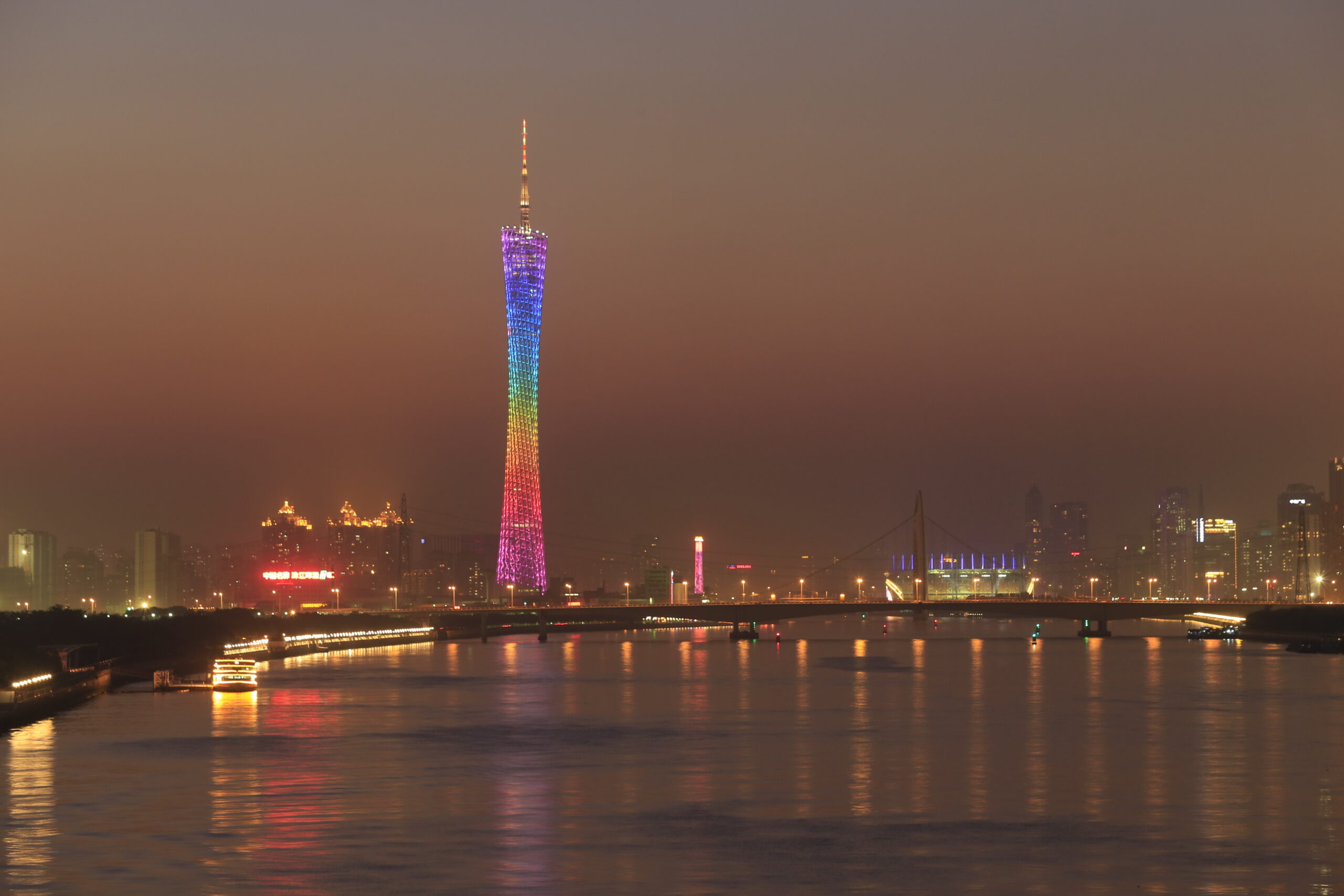
At 600 meters, Canton Tower dominates Guangzhou’s skyline like a graceful hyperboloid waist twisting skyward. Completed in 2010, the tower ranks as the world’s second-tallest TV tower and has become Guangzhou’s most recognizable symbol.
Multiple viewing platforms serve different interests. The main observation deck at 428 meters provides 360-degree panoramic views. On clear days, visibility extends 50+ kilometers. The 433-meter outdoor platform (weather permitting) lets you feel wind and hear city sounds.
The Bubble Tram circles the tower’s waist at 450 meters—currently the world’s highest Ferris wheel, designed to resist 8-magnitude earthquakes and Beaufort scale 12 typhoons. Sixteen transparent pods complete the 20-minute rotation. The transparent floors create stomach-dropping moments as you look straight down 450 meters.
The Sky Drop provides a 30-meter free fall from 485 meters—currently the world’s highest vertical drop ride. The psychological terror of watching the countdown, then feeling your stomach lurch as the floor drops away, creates lasting memories.
We recommend arriving between 4-6 PM to catch both daylight and sunset transitions. The city transforms as lights gradually illuminate. Purchase tickets online through platforms like Klook for savings of 20-30%. Lines for the Bubble Tram can require 45-60 minutes during peak hours—budget time accordingly.
- Metro: Line 3 or APM to Canton Tower Station
- Hours: 10:00 AM – 10:30 PM daily
- Tickets: ¥150-250 depending on activities
- Best time: 4-6 PM for day-to-night transition
4.2 Pearl River Night Cruise

These 60-90 minute cruises pass illuminated landmarks showcasing Guangzhou’s transformation from ancient trading port to futuristic metropolis. Different routes cover varying distances—the most popular runs from Dashatou Pier to Guangzhou Bridge and back, passing Canton Tower, Opera House, Zhujiang New Town skyline, and historic Shamian Island.
Every evening at 8:00 PM and 9:00 PM, buildings along the Pearl River coordinate illumination displays. Canton Tower becomes the show’s centerpiece, cycling through rainbow colors and animated patterns visible for kilometers.
Book the 8:00 PM departure to catch the light show at peak intensity. Ticket prices span from ¥70 for basic open-air boats to ¥200+ for air-conditioned vessels with dinner. We recommend mid-tier boats (¥100-150) offering comfortable seating and good views without excessive crowding.
For the standard route from Dashatou Pier, sit on the left side (port) for optimal Canton Tower views throughout. Bring a light jacket—river breezes cool quickly after sunset.
- Departure piers: Dashatou, Tianzi, or Xidi
- Frequency: Multiple departures 7:00-9:30 PM
- Duration: 60-90 minutes
- Book online: Ctrip, Meituan, or cruise company websites
Part 5: Nature & Family Activities
5.1 Baiyun Mountain

Known as White Cloud Mountain, this sprawling natural area covers 28 square kilometers just 15 kilometers from downtown. The mountain earned its poetic name from clouds that frequently blanket peaks and valleys, especially during early morning.
Moxing Ridge Trail leads to the highest peak at 382 meters elevation. This moderately challenging hike requires 1.5-2 hours ascending stone steps through forest shade. The summit rewards your effort with 360-degree panoramas. Early morning visits (6:30 AM) let you watch sunrise paint the city gold while morning mist creates dramatic atmospheric effects.
The cable car provides quick ascent in about 15 minutes. We recommend hiking up to earn your views, then riding down to save energy for continued city exploration.
Beyond views, Baiyun Mountain hosts diverse attractions: The Sculpture Park features quirky modern art installations. Luhu Lake (Lake of Egrets) offers peaceful walking paths around its perimeter. Nengren Temple sits partway up the mountain with resident monks maintaining daily rituals.
The mountain attracts locals year-round for exercise and nature connection. Weekend mornings bring crowds of families and elderly exercise groups. Watching these activities provides genuine cultural immersion—this is Guangzhou life beyond tourist attractions.
- Metro: Line 3 to Yongtai Station (Exit B1), then bus 24 or 285
- Entry: ¥5 for main area; cable car ¥25-40
- Best time: Early morning (6:30-9:00 AM)
- Duration: 3-4 hours for full summit hike
5.2 Chimelong Safari Park
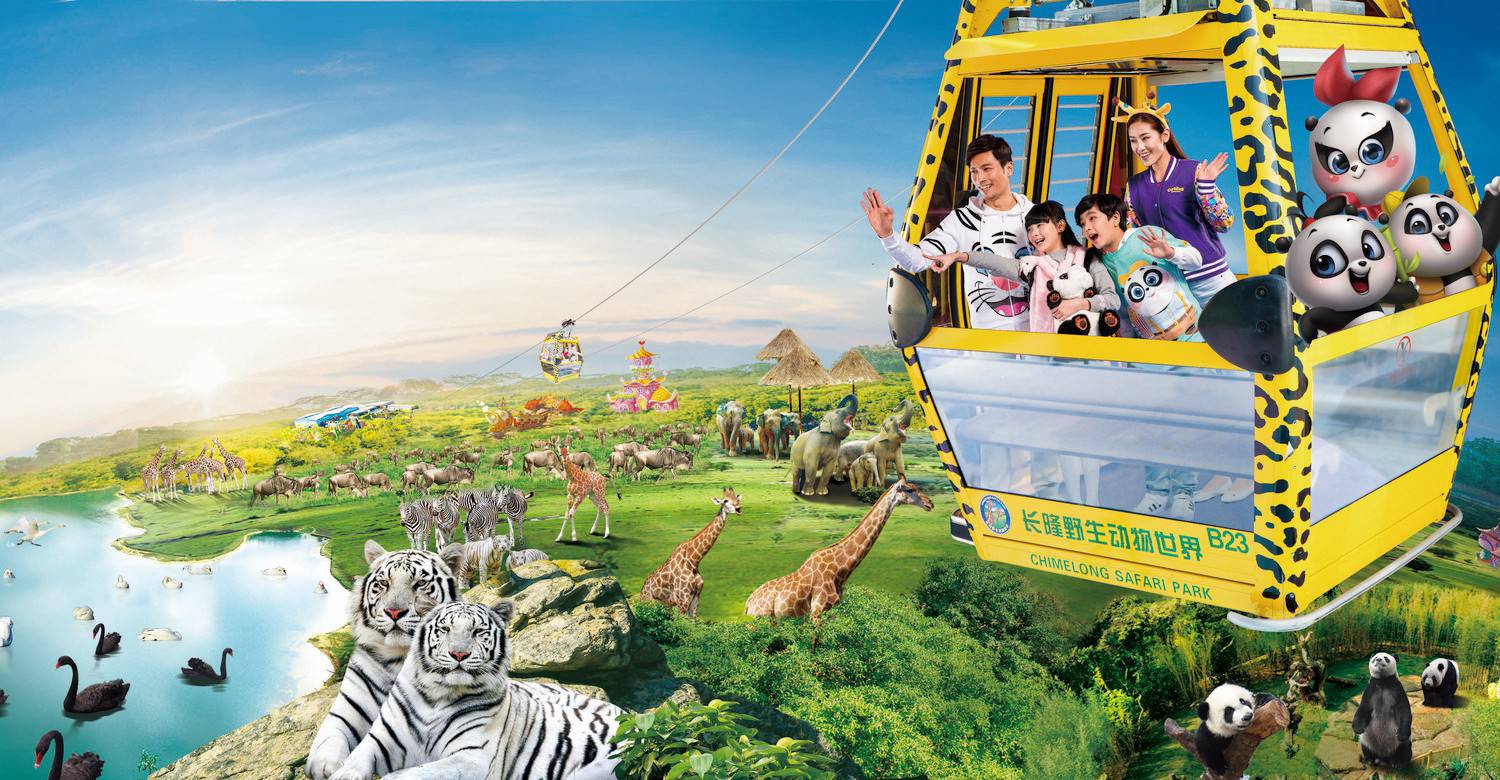
Located in Panyu District, this national 5A park features 500+ species across 133 hectares with spacious naturalistic habitats. Unlike traditional zoos with small cages, Chimelong emphasizes large open habitats mimicking natural environments where animals roam freely.
The self-drive safari lets you drive through large mixed-species habitats. The route winds through African savanna with giraffes and zebras, Australian section with kangaroos, and Asian area with elephants. Animals often approach vehicles closely—giraffes peer into windows, zebras cross ahead.
Giraffe feeding costs ¥20 for lettuce leaves (max 2 persons). Feeding times run 10:00-11:30 AM and 2:00-4:00 PM. Watching a giraffe’s impossibly long purple tongue delicately pluck lettuce from your hand creates memorable moments. Arrive early—sessions attract crowds and have limited capacity.
The park houses Australia’s largest overseas koala colony—over 60 individuals. The panda center features giant pandas in spacious forested enclosures. Unlike some facilities where pandas seem lethargic, Chimelong’s pandas often actively play and interact—signs of good welfare.
Plan a full day with comfortable shoes—expect 15,000+ steps. Start early (9:30 AM opening) to beat crowds and catch animals at their most active. Bring sun protection and snacks to save money.
- Metro: Line 3 to Hanxi Changlong Station, free shuttle
- Hours: 9:30 AM – 6:00 PM daily
- Tickets: ¥300-350 adults (book online for ¥50-80 savings)
- Best for: Families, wildlife photography enthusiasts
Part 6: Hidden Gems
6.1 Hope & Sesame Speakeasy

Hidden behind an old-style Chinese sundry shop on Jianshe Street, this speakeasy transports you to 1920s Shanghai through meticulous attention to historical detail and sophisticated mixology.
Look for red lanterns and vintage items in dusty windows—an unremarkable storefront most walk past without noticing. Spot the golden lionhead door knocker on an evergreen painted door. Step through and navigate past shelves stocked with vintage goods until you find the back entrance leading to a dramatically different space.
Suddenly you’re in a dimly lit cocktail lounge where jazz music drifts through air scented with citrus and herbs. Velvet seating, exposed brick walls, vintage Shanghai posters, and art deco lighting complete the transformation.
The bartenders craft creative cocktails incorporating Chinese ingredients—Sichuan peppercorns, osmanthus flowers, preserved plums, premium baijiu, and artisanal teas. We particularly love their signature cocktails incorporating tea—rare vintage pu-erh and delicate jasmine varieties form bases for surprisingly complex drinks.
Prices reflect quality—expect ¥80-150 per cocktail. Reservations essential for weekends—the intimate space accommodates maybe 30-40 people maximum. Contact via WeChat (most reliable) or phone. The bar attracts sophisticated local crowd mixed with expats and travelers who’ve done research.
- Metro: Line 1 to Changshou Road Station, 10-minute walk
- Hours: 7:00 PM – 2:00 AM (closed Mondays)
- Dress code: Smart casual (no flip-flops or athletic wear)
6.2 Xiguan Mansions & Traditional Alleyways

The Xiguan area in Liwan District preserves Guangzhou’s most authentic traditional neighborhoods. “Xiguan” means “West Gate”—historically the area outside the city’s western gate where wealthy merchants built elaborate mansions during late Qing and early Republic periods.
Traditional Xiguan mansions feature distinctive elements—high ceilings with elaborate wooden beams, colored glass windows depicting landscapes, decorative door panels with intricate carvings, and interior courtyards. Several restored examples now function as small museums open for public viewing, showcasing period furniture and decorative arts.
Beyond restored mansions, real treasures hide in narrow alleyways (lilong) threading between buildings. These lanes preserve traditional neighborhood life—elderly residents sit outside chatting, laundry hangs from bamboo poles, small shops sell daily necessities, and street food vendors set up portable stations.
Xiguan’s greatest culinary contribution might be traditional Cantonese desserts. Small dessert shops serve specialties unchanged for generations—double-skin milk pudding (steamed milk with delicate skin layer), ginger milk curd (hot ginger juice solidifying milk), red bean soup, and herbal jellies. These require specific techniques and fresh ingredients. Prices remain incredibly cheap—¥10-20 for excellent desserts.
We recommend intentionally wandering without fixed destinations. The beauty lies in unexpected discoveries—a tiny temple squeezed between buildings, an elderly craftsman repairing furniture using traditional techniques, or a hole-in-the-wall restaurant serving exceptional food to exclusively local clientele.
- Metro: Line 1 to Changshou Road Station
- Best time: Mid-morning (9:00-11:00 AM) or late afternoon
- Bring: Translation app, curiosity, patience
Part 7: Shopping
7.1 Beijing Road Pedestrian Street

This kilometer-long commercial corridor traces origins back to the Tang Dynasty (618-907 CE). During renovations in the early 2000s, workers uncovered multiple layers of ancient roads. Today, glass panels embedded in pavement let visitors walk over history while viewing these ancient pathways beneath their feet.
The preserved roads sit at different depths reflecting centuries of construction—each dynasty built new roads atop previous work. The layered effect creates fascinating cross-section showing Guangzhou’s evolution. Archaeological markers identify each dynasty’s contribution with Chinese and English explanations.
Beijing Road caters to all budgets. Major malls offer trendy clothes and accessories, while street stalls provide budget fashion. Traditional craft shops sell tea sets, painted fans, jade jewelry, and calligraphy sets—quality varies dramatically so examine items carefully.
However, many restaurants along Beijing Road target tourists with inflated prices and mediocre quality. The most authentic food hides in back streets just blocks away. Walk perpendicular to Beijing Road into smaller lanes where locals actually eat—prices drop dramatically and quality improves substantially.
Traditional bakeries sell wife cakes and almond cookies—excellent gifts that travel well. The night market (5 PM – midnight) brings incredible energy with vendors, street performers, and bustling crowds.
- Metro: Line 1 or 6 to Beijing Road Station
- Hours: Shops 10 AM – 10 PM; night market 5 PM – midnight
- Best time: Early evening (6-8 PM)
7.2 Shangxiajiu Pedestrian Street
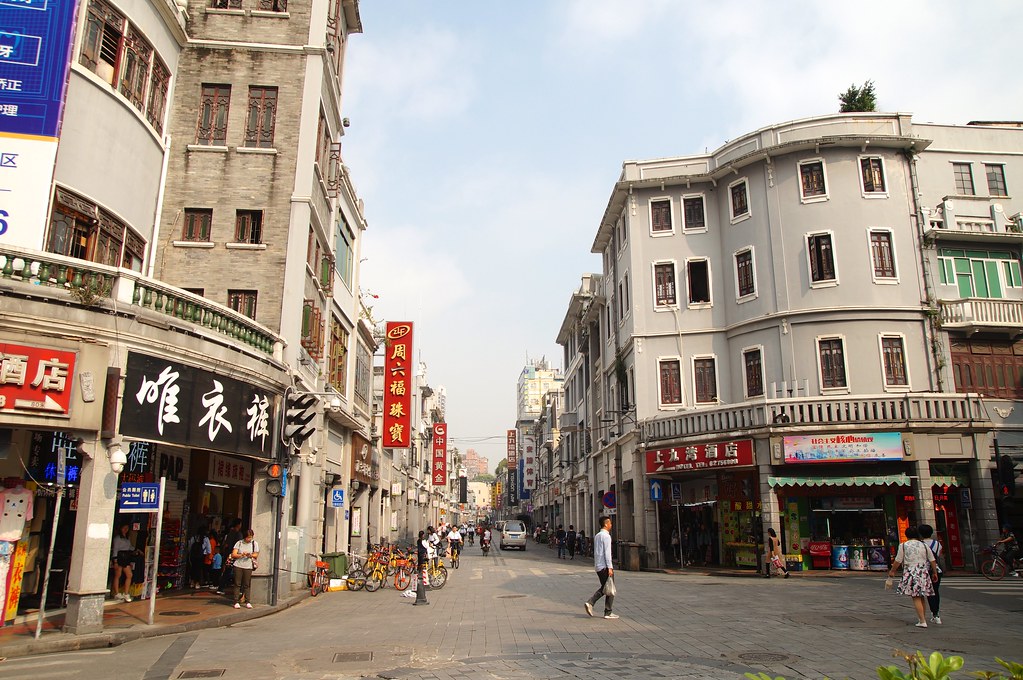
Located in Liwan District, Shangxiajiu offers shopping experiences more traditional than Beijing Road. The street features Guangzhou’s longest intact qilou street where continuous covered walkways protect pedestrians.
Unlike Beijing Road’s modern mall dominance, Shangxiajiu retains more traditional street-level shops. Traditional Cantonese bakeries line the street selling local specialties. Clothing shops offer more affordable fashion with better value for budget shoppers.
Tea shops sell premium Guangdong teas including renowned oolong varieties. Knowledgeable staff can explain different teas and proper brewing methods—meaningful gifts for tea enthusiasts.
- Metro: Line 1 to Changshou Road Station (Exit D)
- Hours: Shops 10 AM – 10 PM
- Best for: Traditional pastries, affordable clothing
7.3 Taikoo Hui

For international luxury brands and upscale dining, Taikoo Hui in Tianhe district delivers world-class shopping. International luxury flagships include Louis Vuitton, Gucci, Prada, and Hermès. Contemporary fashion brands occupy mid-level floors.
The restaurant selection impresses—upscale Cantonese restaurants serve refined interpretations, while international cuisines include excellent Japanese, Italian, and French restaurants. Art installations throughout add cultural dimension.
- Metro: Line 1 or 3 to Shipaiqiao Station (underground connection)
- Hours: 10 AM – 10 PM daily
- Price level: Luxury to premium
Part 8: Canton Fair Travelers

8.1 Understanding the Canton Fair
The 138th Canton Fair (Fall 2025) divides into three five-day phases:
- Phase 1 (Oct 15-19): Electronics, appliances, machinery, building materials
- Phase 2 (Oct 23-27): Consumer goods, gifts, home décor, furniture
- Phase 3 (Oct 31-Nov 4): Textiles, clothing, shoes, office supplies
The Pazhou Complex covers 1.55 million square meters—Asia’s largest exhibition center. Download the official Canton Fair app for navigation and exhibitor directories.
8.2 Efficient Strategies
Expect to walk 15,000-20,000 steps daily. Comfortable shoes with good support aren’t optional—they’re mandatory. Arrive at venue by 9:00 AM when exhibitors are fresh. Focus mornings and early afternoons on serious business. Leave by 5:00 PM for evening exploration.
What to Bring:
- Rolling luggage for catalogs and samples
- 200-300 business cards (English and Chinese)
- Power bank for phone charging
- Water bottle and light snacks
Hotels near Pazhou fill months ahead—book immediately after confirming attendance. Metro Line 8 provides direct access to Xingangdong Station connected to venue. Hotels in Zhujiang New Town offer better dining and entertainment during non-fair hours.
8.3 Evening Activities
Canton Fair schedules allow evening exploration—most exhibitors leave by 6:00 PM. Suggested activities:
- Evening 1: Pearl River Night Cruise (8:00 PM)
- Evening 2: Yongqingfang + Hope & Sesame speakeasy
- Evening 3: Traditional dim sum dinner
- Weekend: Chimelong Safari Park or Baiyun Mountain
Chinese partners often appreciate foreign visitors showing genuine interest in local culture beyond transactions.
Part 9: Sample Itineraries

9.1 Three-Day First-Timer Route
Day 1: Old Guangzhou
- 8:00 AM: Yum cha at Tao Tao Ju
- 10:30 AM: Chen Clan Ancestral Hall
- 2:00 PM: Temple of the Six Banyan Trees
- 3:30 PM: Yuexiu Park—Five Rams Statue, ancient city wall
- 7:30 PM: Pearl River Night Cruise
- 9:30 PM: Late dinner near Canton Tower
Day 2: Modern Guangzhou
- 6:30 AM: Baiyun Mountain sunrise hike
- 2:00 PM: Canton Tower observation decks & Bubble Tram
- 5:30 PM: Zhujiang New Town & Opera House exploration
- 7:30 PM: Yongqingfang traditional neighborhood
- 9:00 PM: Dinner featuring Cantonese specialties
Day 3: Culture & Hidden Gems
- 9:00 AM: Museum of Mausoleum of Nanyue King
- 11:00 AM: Shamian Island leisurely walk, coffee break
- 1:00 PM: Lunch at traditional Cantonese restaurant
- 2:30 PM: Qingping Market exploration
- 4:00 PM: Beijing Road shopping, ancient road viewing
- 9:00 PM: Hope & Sesame speakeasy (reservation required)
9.2 Five-Day Comprehensive Experience
Add these to the three-day route:
Day 4: Family Entertainment Full day at Chimelong Safari Park (9:30 AM – 6:00 PM). Start when gates open for maximum animal activity. Evening return to Tianhe for dinner.
Day 5: Choose Your Adventure
Option A – Cultural Heritage:
Metro to Foshan (30 minutes) for kung fu heritage sites, ancient temples, and traditional ceramics workshops. Return for farewell dinner in Guangzhou.
Option B – Local Immersion:
Sleep in after active days. Late morning neighborhood market visits. Afternoon traditional tea ceremony at specialty tea house. Evening upscale Cantonese dinner.
Option C – Relaxation:
Morning at Taikoo Hui luxury mall. Afternoon spa treatment. Evening rooftop bar with city views plus farewell dinner.
Frequently Asked Questions – Things to Do in Guangzhou

Q1: How many days do I need in Guangzhou?
Three days cover major highlights comfortably allowing time for food culture, historical sites, and modern attractions. Five days enable deeper exploration including day trips. Canton Fair attendees typically need six days—three for business, three for sightseeing and relationship building.
Q2: Is Guangzhou expensive?
Guangzhou offers excellent value compared to Shanghai, Beijing, or Hong Kong. Budget travelers manage on $40-60 daily including hostel accommodation, street food, and public transportation. Mid-range visitors spending $80-120 enjoy comfortable hotels and quality dining. Luxury standards costing $200+ provide five-star experiences at prices substantially lower than comparable Western cities.
Q3: Do I need a visa?
Most nationalities require Chinese visas for regular tourism. However, Guangzhou offers 240-hour (10-day) visa-free transit for travelers from 54 eligible countries with onward tickets to third countries. This policy expanded from 144 hours in December 2024. Hong Kong, Macau, and Taiwan count as separate regions for this policy. Your passport must remain valid for at least 3 months from entry date.
Q4: Can I use credit cards?
Major hotels, shopping malls, and tourist attractions accept international credit cards (Visa, Mastercard, American Express). Smaller restaurants, traditional markets, street vendors, and family-run shops prefer cash or Chinese mobile payment (WeChat Pay, Alipay). Carry cash for daily expenses while using cards for hotels and major purchases.
Q5: Is food safe for foreigners?
Guangzhou’s food safety standards rank among China’s highest due to prosperity and strong regulatory enforcement. Choose restaurants with visible kitchens and good customer traffic. Street food from busy stalls typically remains safe—popularity indicates both taste and reliability. Most visitors experience zero food-related illness following basic precautions.
Q6: How do I get from airport to downtown?
Line 22 Express Metro connects Baiyun Airport to Guangzhou South Railway Station in 25 minutes (¥7). Transfer to other metro lines for all downtown areas. This provides fastest, most economical transportation. Taxis cost ¥120-180 depending on destination and traffic, requiring 45-90 minutes downtown.
Q7: What’s the best way to experience food culture?
Book a food tour or hire a guide for your first dim sum experience. Learning proper yum cha etiquette, dish names, and ordering strategies enriches all subsequent meals. Professional guides help visitors skip lines, order optimal dishes, and understand cultural context—transforming dining from mere eating into genuine cultural education.
Q8: Are English-speaking guides available?
Reputable agencies like us offer English-speaking guides with deep Guangzhou knowledge. Quality varies significantly—better guides cost more (¥800-1,500 per day) but provide dramatically richer experiences. Book ahead especially during Canton Fair periods when demand peaks.
Q9: What should I avoid?
Don’t drink tap water, discuss sensitive political topics publicly, photograph military installations, jaywalk (fines enforced), or speak extremely loudly in public spaces. Respect temple customs—remove hats, speak quietly, don’t point at Buddha statues. Avoid aggressive bargaining in fixed-price stores. Don’t accept unsolicited offers from strangers for special deals—these sometimes involve scams.
Final Thoughts
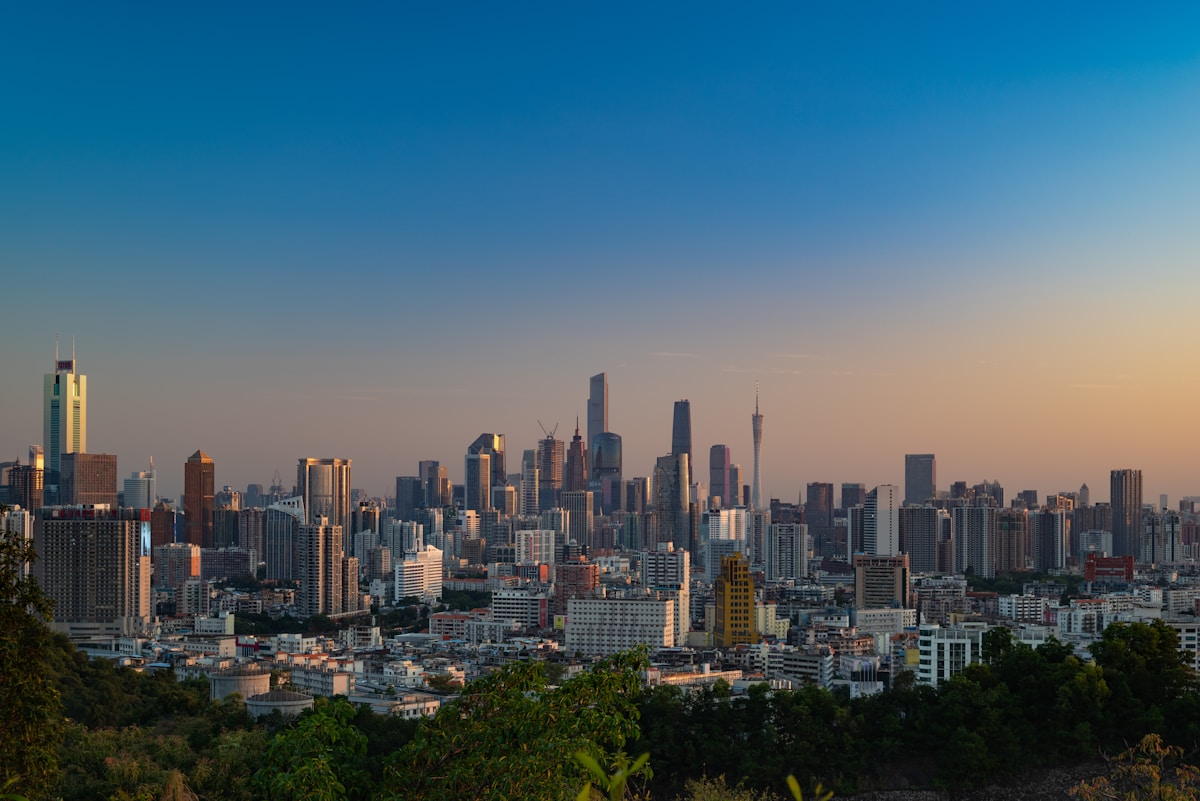
Guangzhou rewards travelers who approach with curiosity rather than mere efficiency. The city’s magic appears in unexpected moments—elderly neighbors playing mahjong in centuries-old courtyards while luxury cars idle at lane entrances, master craftsmen hand-pulling noodles using techniques unchanged for generations, impromptu opera performances in parks where tradition persists despite surrounding skyscrapers, or that perfect bowl of wonton soup discovered by following your nose down unmarked lanes.
We’ve outlined essential experiences spanning heritage sites, modern marvels, culinary adventures, and hidden gems that most guidebooks miss. But Guangzhou’s real charm transcends any itinerary. The city invites wandering—those unplanned detours between metro stops, accepting tea invitations from curious locals, trying dishes whose names you can’t pronounce, getting temporarily lost in Xiguan’s twisting alleys and discovering authentic moments impossible to plan.
This city transformed from ancient Silk Road trading port to futuristic megalopolis while miraculously maintaining its soul. Grandmothers still practice tai chi at dawn in parks shadowed by glass towers. Family-run dim sum shops pass recipes through six generations. Cantonese opera echoes from community centers where elderly performers keep traditions alive. The Pearl River still flows through the city’s heart just as it did 2,000 years ago when Guangzhou first emerged as China’s southern gateway.
Guangzhou doesn’t shout for attention like Beijing’s imperial grandeur or Shanghai’s art deco glamour. It whispers—come closer, look deeper, taste this, understand our story. Those who listen discover why this city has thrived for over two millennia while remaining remarkably, authentically itself. The cuisine that conquered global Chinatowns originated in these streets. The merchants who built fortunes trading silk, porcelain, and tea walked these same lanes. The revolutionary ideas that transformed modern China germinated in these neighborhoods.
Come with open mind and flexible schedule. Bring comfortable shoes and healthy appetite. Pack patience for navigation challenges and excitement for discovery. Let Guangzhou surprise you, challenge your expectations, and ultimately reveal its layered complexity. The city rewards those efforts with memories, flavors, and insights that persist long after you’ve returned home.
The best Guangzhou stories can’t be planned—they unfold through serendipity, curiosity, and willingness to embrace the unexpected. Your Guangzhou adventure awaits with steaming dim sum, glowing skyscrapers, ancient temples, and countless moments of magic hiding in plain sight.
Travel China With Me specializes in authentic Chinese experiences beyond typical tourist routes. Our local experts design personalized Guangzhou itineraries matching your interests, schedule, and travel style. Contact us for custom planning that transforms good trips into unforgettable journeys.


